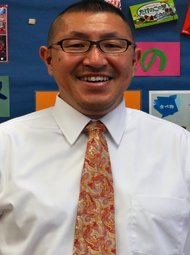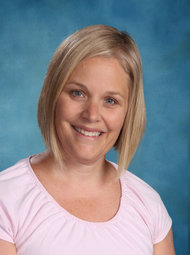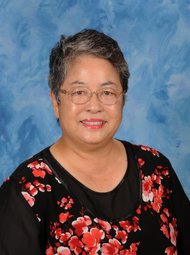2014 Award Recipients

Mr. Tomokazu Morikawa
Japanese Language Category
Teacher of Japanese Language and Culture
George Washington High School, San Francisco, CA
Mr. Tomokazu Morikawa is an enthusiastically committed Japanese language educator. Mr. Morikawa has created entire curricula with thematic and interdisciplinary approaches that promote teaching Japanese cultures in Japanese. He has developed international expedition programs for his students and has established sister school relationships with public high schools in Osaka in the past. Presently he has established sister school relationships with high schools in Miyazaki, Tochigi, Sendai and collaboration projects with Fukui prefecture.
His project-based units have contributed innovative ways of teaching a foreign language to students within the SFUSD. For example, Tomokazu has worked with local Japanese travel agencies and the San Francisco Travel Bureau to create mini tour itineraries and guidebooks in Japanese for tourists from Japan. His students arranged walking tours for Japanese tourists during the summer, allowing students to discover different values and perspectives between Japanese cultures and their own.
Since early 1990’s he has taken his students on summer trips to Japan, visiting sister schools, collaborating in a variety of projects and activities with all sister schools. Since the Great East Earthquake in 2011, he takes his students to visit Tohoku. In the summer of 2012 they visited Kita-Ibaraki, volunteering in beach cleanup and other locally based community activities. They have visited their sister school in Miyagi where he and his students have presented approximately 13,000 dollars in relief funds that his students raised. His students have initiated various projects to support high school students in Tohoku, creating video message boards, Facebook page and community based projects in San Francisco and in Tohoku. In the summer of 2014 he will be taking students to Japan, visiting Miyagi and again promoting communities that bridge the gap.
About twenty years ago, Tomokazu started his teaching career with the San Francisco Unified School District, creating an innovative and rewarding new curriculum in an academically low performing school within the district. His challenge as a new teacher was to create interdisciplinary units associated with learning Japanese Language and cultures for a 110- minute block schedule. He is a native speaker of Japanese, educated in Japan as well as in the United States. Mr. Morikawa has received Outstanding Teacher of the Year award by Asian Week Foundation for his community outreach programs for his students. He has served as vice president for the California Association of Japanese Language Teachers (CAJLT), currently a board member of the Northern California Japanese Teacher’s Association (NCJTA) and the Japanese American Association of Northern California (JAANC). He has developed curricula, lesson units and projects for SFUSD, the College Board, and the Asian Art Museum in San Francisco. He has also given numerous workshops and presentations locally and regionally. He is currently a moderator for the AP teacher online community for Japanese language and culture.

Ms. Lori Snyder
Humanities Category
History Teacher
Longmeadow High School, Longmeadow, MA
Ms. Lori A. Snyder is currently a history teacher at Longmeadow High School in Longmeadow, Massachusetts where she has taught Asian Studies, World History and United States History since 1996. During that time she has served as district social studies coordinator, department chair as well as the East Asia Club Advisor.
Ms. Snyder’s academic interest in Japan began during her undergraduate years at Hamilton College. She studied East Asian history under the instruction of Professors Miriam Silverberg and Thomas A. Wilson. Her primary area of historical interest was the work of the famous Kokugaku scholar, Motoori Norinaga. A member of Phi Beta Kappa, she was awarded the Edwin B. Lee Award in Asian History and became a Japan Exchange and Teaching Program (JET) participant in Mie-Prefecture, 1992-1994.
Ms. Snyder’s experiences as a JET influenced her decision to become a history teacher in the U.S. and to work to foster relationships between American and Japanese youth. Since her arrival at Longmeadow H.S., she has established the East Asia Club for students who share interest in the region. She brought a first group of Longmeadow students to Hokkaido, Japan in 1997 to attend the Pacific Education Conference. She created a student exchange program with a sister school in Yangzhou, China in 2003 and brought the first group of students there in 2004. In 2007, inspired by spending a summer at Beloit College learning Japanese under Dartmouth Professor Mayumi Ishida, she created an exchange program between Longmeadow and Takikawa City, Japan. She has led three additional student exchange trips to Japan since 2008. In order to support these programs, Ms. Snyder has written and received grants totaling over $15,000 from both the Freeman Foundation and the Longmeadow Excellence in Education Foundation.
To keep her knowledge of East Asia current, Ms. Snyder has participated in numerous national teacher institutes such as PIER at Yale University, an NEH at the College of the Holy Cross, Global Outreach Center, Clark University, Five College Center for East Asian Studies and Teaching East Asia (TEA) at the University of Colorado, Boulder. She has conducted numerous in-service programs and professional growth courses to her fellow colleagues at the high school and at the district level. In addition, she has been a board member of the Massachusetts-Hokkaido Association for the past 8 years and is currently involved in planning a 25th anniversary celebration for 2015.
2015 will mark the tenth anniversary of the Longmeadow-Takikawa Exchange Program. Ms. Snyder is excited to use the grant money to offer student scholarships and to provide three new teachers the opportunity to visit Takikawa during the summer of that year. She hopes that by introducing more teachers to Japan that they will be touched by the experience and will devote their time and energy to helping sustain the exchange program well into the future.
At the back wall of her classroom is a wishing well with a proverb that states, “The frog at the bottom of the well cannot see the great ocean”. Each year the well is covered with origami frogs representing the senior students in her Asian Studies class. It is her mission to expose her students to a world larger than Longmeadow through their study of Asia.

Ms. Yasuko Kawabata
Special Commendation Award
Japanese Host Nation Culture Teacher
Amelia Earhart Intermediate School, Okinawa, Japan
Ms. Yasuko Kawabata is the recipient of a Special Commendation Award for her life-long efforts to help Americans learn more about Japan as a host nation teacher at the Amelia Earhart Intermediate School, a Department of Defense Dependents School in Okinawa, Japan, where she began teaching in 1983.
She writes the following about her experiences:
At the beginning, it was not easy to adjust to the ways of an American School. Thirty-one years have passed; however, my early struggles have been rewarded by what I have learned from the children and the smiles we have shared. I am one of sixteen Japanese Host Nation Culture teachers. Our students are in third through fifth grades. I am responsible for teaching six classes in four days, a total of twenty-four classes and five hundred students a week. Each class is 45 minutes long. The school’s Japanese Culture curriculum is rich in content. It includes Japanese language, history, geography, sign language song, traditional folk art and crafts, such as origami and sumie paint, calligraphy, as well as discussions about both, the Okinawan and Japanese daily life styles, customs, and festivals.
As a part of the Japanese Culture classes and the community relations program on Okinawa, I have been involved with the coordination and support of the Okinawa homestay program. Children of both, the Japanese and American countries experience each other’s culture by living with families in Okinawa City and on United States Military Bases. In addition, every year during the Christmas season, I have been involved in the coordination of inviting children from Okinawa City to spend the Christmas holidays with American families on the various military bases. In turn, American children are hosted by families of Okinawa City to experience the New Year’s celebrations. The children spend two nights and three days with their host families to develop a better understanding of each other’s cultures. This exchange program helps the children broaden their international experiences in creative and enjoyable ways. For the past ten years, this exchange program has been continuously supported by many people.
Another important cultural exchange program, in which I am involved, is the Children’s Artwork Exhibition, an art show featuring artwork done by students from Okinawa City and U.S. Military Bases. On the first day, we hold a reception for the young artists and their families. This program is a wonderful place for friendship exchange between Japanese and American families. The Children’s Artwork Exhibition has been going on for more than ten years. I refer to this program as the “pipeline” between the people of Okinawa City and U.S. Military Bases.
The American and Okinawan children who have participated in these programs have memories that will last a lifetime. I pray that their happy experiences will continue to bring friendships and peace to both cultures as we live harmoniously together on Okinawa and Japan. I hope the children will take these experiences with them out into the world and build upon them to promote and encourage lifelong cherished memories. As a citizen of Okinawa, I hope to continue to be an instrumental force in these programs that will encourage our children to strengthen the bond and promote lifelong friendship between Okinawa and the United States military communities.


